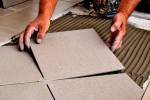Kits let novices create faux finishes at home
Is the sponged-wall look an appealing one? Is the pickled look attractive? Is wood graining desirable? Would you like the look of a rich suede wall?
Is paying to have any of this done professionally not exactly as appealing, attractive or desirable?
Well, not to worry. There are faux finishes that are easy to apply even for the novice.
First of all, before tomatoes and raw eggs are hurled at my windows, I must say that having walls or furniture painted by a reputable and talented professional will probably result in a better finish. It will have that artistic quality that only a trained professional would be able to produce.
But if doing it yourself might be where it's at for right now, read on.
Sponge painting involves blotting paint onto a surface by means of a sponge. The surface must first have a base coat colored to complement or contrast the sponge color. Selecting complementary or contrasting colors for sponging can be the biggest problem. If the color is sort of OK but maybe too dark, water might be added or white paint might be mixed in to lighten it.
While all of that usually is done by trial and error, there are sponging kits available that come prematched. A light color used as the base coat will be prematched with a darker shade for the sponging. Then a clear coat is available that will both glaze and add texture to the wall.
What about the ever-popular pickled look? To pickle wood, you would need to thin the paint to be used, brush it onto raw wood and then wipe it off. Thinning the paint is the most difficult part. Thinning too much results in not enough color; not thinning enough gives too intense of a color, particularly in the grooves of the grain.
Guess what? There are products out there that take all the guesswork out of pickling. These products are usually water-based, making them user-friendly.
Making a surface look like natural wood graining is the most difficult of the three faux finishes mentioned above. This one should really be done by a pro. But if you are a diehard do-it-yourselfer, there are products available that will make the completion of this job possible.
The products usually consist of a three-step process: 1) brush on the base color and let it dry; 2) brush on a graining glaze over the base color; and 3) while the graining glaze is still wet, use the graining tool (that usually comes with the kit) to make various grains on the surface -- i.e., mahogany, oak, cherry.
Suede walls are rich-looking and once needed the hand of a professional to look authentic. Now there are products available for the do-it-yourselfer that will help you along. The premixed products impart the look and feel of authentic suede and can be used on wallboards, plaster, wood, masonry and brick.
Rosemary Sadez Friedmann, an interior designer in Naples, Fla., is author of "Mystery of Color."























